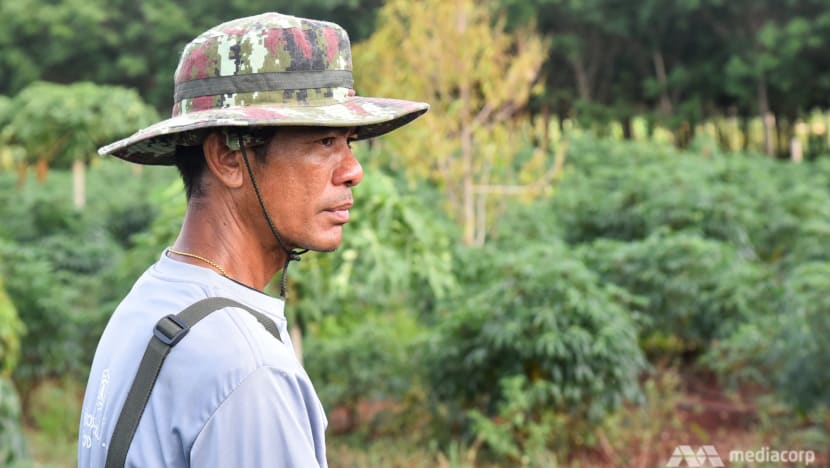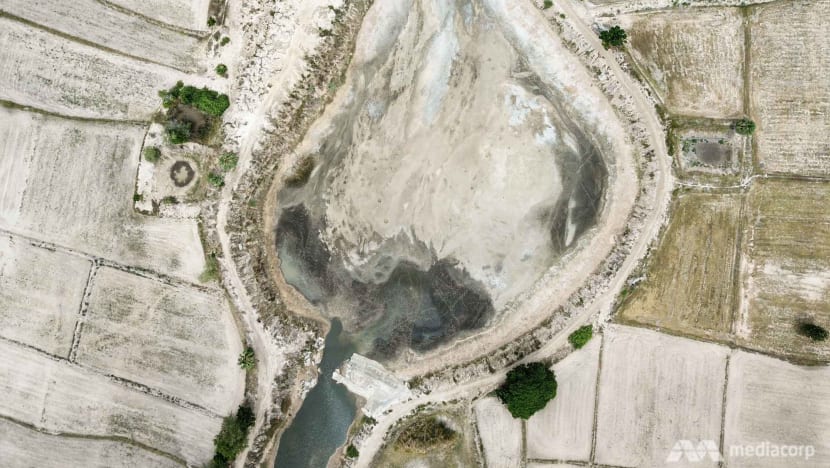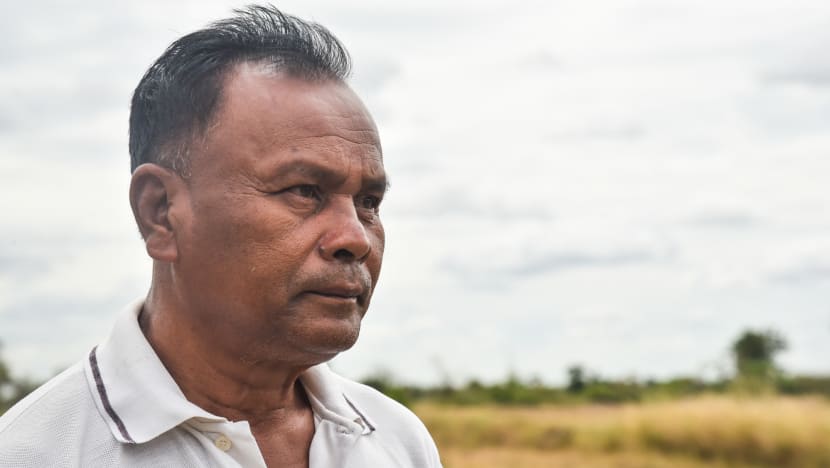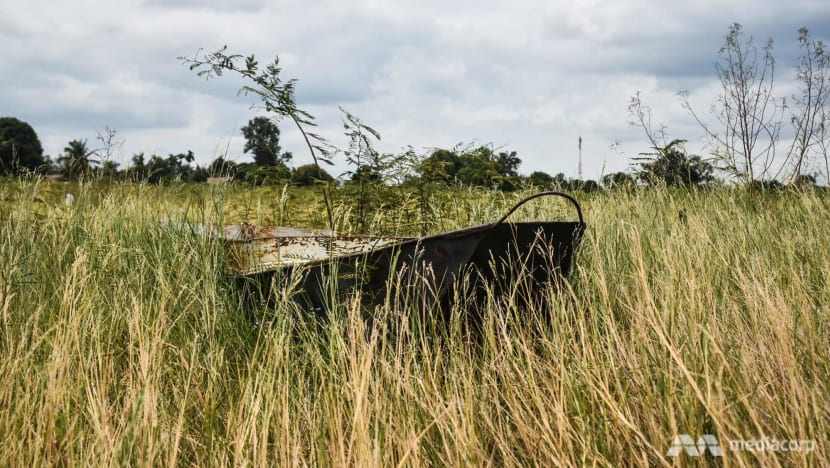When the rain doesn’t come: Thailand in grip of severe drought as monsoon season fails to deliver

There has been no significant rain in this province for several months. (Photo: Jack Board)
NAKHON RATCHASIMA, Thailand: Suthin Noramas cannot stop his tears as he surveys the parched land around him.
His plot is about 2.25 hectares in size and has been carefully cultivated for some crops he thought would prove to be valuable to sell, such as durians, pepper and lemongrass.
All of them are dying or dead.
The ochre ground is cracked from dryness. Even the sections that look green and thriving belie the lack of rain that has hit hard over the past few months. “I have been doing agriculture my whole life,” the 43-year-old said, eyes wet with despondency. “This drought is the worst.
“You can clearly see that they've died. I have lost all courage to work. It’s all gone. Dry.”
Ask any local in this part of Thailand and their answer will be similar: This drought is as bad as they can remember.

So far this year, the entire country has endured the least rainfall in the past decade and a significant 25 per cent less than in the same time in 2018, according to Thailand’s Department of Water Resources. In Issan, which covers 20 provinces across a large swathe of the northeast of Thailand, the drop has been more dramatic - down 30 per cent on 2018 figures, where rainfall was close to normal.
The state of the Mekong River this wet season - where it fell to its lowest water level in 100 years - has been symbolic of the bigger problems facing the region.
The lack of rain has left a visible mark on the land and raised uncertainty among people.
Suthin works his land with his elderly father. Their only source of water for their agriculture project is a nearby reservoir. Recently, the duo purchased an electric pump to help them extract the precious resource. On this day, and in recent memory, there is nothing but a dirty trickle.
“I don’t know why it is like this. I don’t know why the gods, sky and soil are punishing me like this. What is going on this year and why is there no rain?”

Just a few kilometres away in Khonburi, other locals ponder that same question on the edge of another dried up reservoir. Its capacity is about 12,000 cubic metres, or about six Olympic-sized swimming pools. But it is empty now.
Local flower grower Karawake Korbsungnern says he has lost 50 per cent of this year’s harvest, costing him about US$6,500. He thinks he is lucky to have managed to salvage anything at all in the absence of rain.
“There are so many dark clouds coming this way but the rain doesn’t come. It rains somewhere else. It’s so windy here, too, but no rain. I have been watching weather forecasts and they always say there will be rain. I have yet to see any,” he said.
“If rain and water don’t come by October. I don’t know what will we do next year.“

CLIMATE CHANGE AND MISMANAGEMENT
In July, Thailand’s meteorological department issued a warning about the severity of the drought. Around the same time, the government told farmers to hold off planting rice. It came months too late for many producers, who typically plant their main crop in May.
Unlike in previous bad drought years - 2015 being a recent example - it meant farmers had fully committed to their fields, leaving them horribly exposed when the monsoon failed to form as usually expected in May and June.
Prapas Khunsarong, a rice grower in Non Thai district has watched his fields fail after investing huge sums of money. He is mostly a subsistence farmer, growing rice for his own family’s needs.
Around Baan Wang village, the sight of dry paddies and scorched earth are the evidence of the struggle of Prapas and many like him. They say there has not been any significant rainfall in months.

“At the beginning of this year there was some rain and the rice was sprouting. After that for about three months, there’s been no rain. They are all dead,” he said.
“Next year, we are facing the problem of no rice to eat and no grains to grow. These are the problems. We do lose hope. The whole sub-district feel the same way.”
Rice production in Thailand is a critically important industry, which accounts for about a quarter of the world’s global trade of the crop. Yet, the country has food security issues due to climate change vulnerability, according to Dr Seree Supratid, director of the Climate Change and Disaster Center at Rangsit University.
This year’s drought is being blamed on a low pressure trough, bringing monsoonal rain shifting to the north, inundating parts of India and southern China instead of Thailand. But on top of climate conditions, Dr Seree, the former governor of the country's Provincial Waterworks Authority and author for the United Nations Intergovernmental Panel on Climate Change, says water mismanagement can further explain the damaging impact.

“At the beginning of this year we had quite a lot of water for the farmers. We released so much water. Why release so much? Because we didn’t tell the farmers and all the stakeholders before the beginning of the year that we will face some period of prolonged drought,” he said, referring to stored water that can be freely accessed by farmers during the normal dry months.
“We have to improve. We have to change our way of management.”
Already this year, a study by the Department of Agricultural Extension estimated that 1,331 square kilometres of land has been damaged by the drought at a cost of US$320 million. The numbers are expected to dramatically increase as the drought continues.
Dr Seree blames a lack of proper forecasting, information spreading and risk mitigation for Thailand’s lack of climate resilience. A lack of investment in agricultural technology or the encouragement of adoption of high-value crops that use less water has further contributed, he says.
These are challenges that are only going to become more pressing in the years to come. Dr Seree says a hot and dry climate is a new reality for Thailand and severe droughts are now being forecast every two to three years, instead of every 10 to 15 years in the past. Likewise, the magnitude and regularity of damaging floods is also increasing.
“We see that in the long term, Thailand will be a very vulnerable country,” he said.
Meanwhile, the government is taking action to deal with the current situation.
The cabinet on Tuesday (Aug 28) approved an additional drought relief package worth US$515 million to reach 76 hard-hit provinces. Prime Minister Prayut Chan-o-cha also proposed waiving water bills for the public in central Surin during a visit this month.
"People are beset by grievances. They turn on their tap only to have air come out of the pipe. Why should they be paying for water that isn't there?" he said, as reported by local media.

‘WE HAVE TO FIGHT’
As the Lam Chae Dam has slowly receded, it has left boats lying on cracked mud and waterside restaurants high up and away from their intended idyllic locations. The water level has dropped so much, motorcycles can traverse a path right across the large reservoir.
The dam is a critical piece of water infrastructure serving Nakhon Ratchasima province with a capacity of 275 million cubic metres. Currently, it is only 17 per cent full. Its operators have closed access to water collection for agricultural purposes, allowing people only to take enough need for personal needs.
“We want to reserve some water for next year’s dry season and we will keep water from rainfall. We closely monitor the situation,” said Somsak Thaploka, the director of Lam Chae Water Transmission and Maintenance Project.

Just nearby, the concerns for villagers in Kok Kra Chai relate to drinking water. Their small reservoir will run dry within two weeks if there is no rain. Many locals typically use ceramic water pots to collect rainwater to drink and wash with - those are also sitting empty.
“The water is at its lowest we have seen. If there’s no water then villagers have to buy water,” said village head, Prajuab Thokratoke.
The Thai government will provide some compensation for affected farmers during this drought period but it is likely to not even come close to covering their costs. For provinces declared disaster relief zones, rice farmers could receive a maximum of US$36 per rai of land (0.16 hectares). Farmers say the cost of planting one rai is about triple that sum.
“They will give compensation but it won’t be enough. It will only be enough to prolong us for a while, to buy food because we don’t grow rice here so we have to buy rice. I have to help myself first,” said fruit farmer Suthin.

He is torn between holding out, absorbing his losses and the grief it brings or packing his bags for Bangkok and finding a construction job with a regular pay packet.
“If I really cannot cope with this, I have to find a job in town. As for the crops, I will leave them here for my father to look after on his own. But he’s old,” he said, before seeming to change his mind, drawing on the grit farmers often do to survive tough times like these.
“We have to fight. It’s true. We have to fight. We just have to wait for rain.”
Additional reporting by Ryn Jirenuwat.














